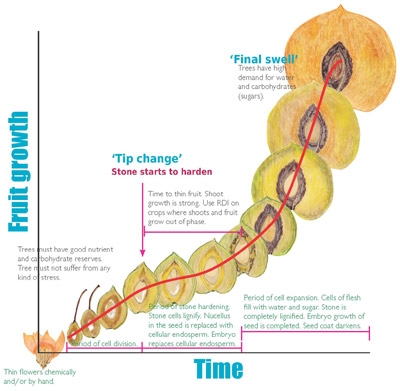Fruit of peach, nectarine, plum, cherry and apricot follow a predictable growth pattern.
The three parts of the fruit: the seed, the stone and the flesh, develop separately over time, and fit in with other growth patterns of the tree, such as growth of new shoots.
An understanding of the development of these parts of the fruit will help you to schedule your irrigation, to time your thinning, and to maximise size of fruit at harvest.
RDI
Many orchardists have heard of RDI (Regulated Deficit Irrigation). RDI can save water and money by reducing irrigation and pruning. Although under RDI trees are purposely stressed for water, the words Regulated Deficit Irrigation imply, that RDI is not a haphazard neglect of irrigation, but a carefully planned irrigation strategy.
RDI aims to manipulate the seasonal growth pattern of the trees and channel more tree resources into fruit rather than into shoot growth.
RDI only for selected crops
With some fruit crops, such as canning peaches, and late maturing market peaches, nectarines and plums; fruit and shoot grow out of phase, that is, they grow at different times.
RDI can be applied to these fruit crops because the growth of new shoots can be controlled without affecting the growth of fruit.
With peaches, nectarines and plums that mature early in the season, and also cherries and apricots—fruit and shoots grow at the same time, and RDI is not recommended.
Fruit growth stages
Cell division
After flowering and fruit set, there is a period of several weeks when cells are formed in the flesh and stone. This is called the period of cell division.
Stone hardening
Following the period of cell division, the tree will look after the reproductive part of its fruit, namely the seed.
A hard shell around the seed, called the stone, protects the seed from getting damaged.
As the seed grows to its full size, the stone hardens (lignifies) around the seed. This is called the period of stone hardening.
Cell expansion
When the stone has lignified and the seed is fully developed, the trees will fill the cells of the flesh with sugar and water (Figure 1).
This is a period of cell expansion and is usually much longer than the period of cell division.
Final swell
Cells expand rapidly, especially towards the end of the growth cycle when time of harvest approaches.
This is called the final swell, and the demand for water by the tree is high.
Leaves
The leaves have to work hard to produce the carbohydrates that form sugar. The leaves can only work hard if the tree can capture plenty of sunlight and this sunlight can penetrate through the canopy.
Follow the growth cycle
By cutting several fruit through the suture line with an anvil-type pair of secateurs, you can follow the growth cycle of your fruit and determine when you should apply RDI, where applicable, and also when you should start and finish thinning.
You can also determine when the fruit reaches ‘final swell’ (see Figure 2).
Thinning fruitlets or flowers
Thinning fruitlets is one of the most expensive and labour-intensive exercises.
Thinning fruitlets also exacerbates the incidence of split stone.
More and more stone fruit growers are starting to realise that size of fruit at harvest can be greatly improved by thinning flowers by hand, chemically or both; and if necessary by following this up with a quick thin of fruitlets.
Varieties that mature early and/or are hard to size, benefit from flower thinning.
To thin flowers and fruitlets to obtain the sizes of fruit that the markets demand, you must know how the fruit of different varieties behave.
Fruit set, premature fruit drop and ‘doubling’ are factors you must put in the equation when you try to regulate your crop.
By periodically examining your stone fruit, you take the guesswork out of managing your orchard.
See this article in the October 2012 Tree Fruit






















